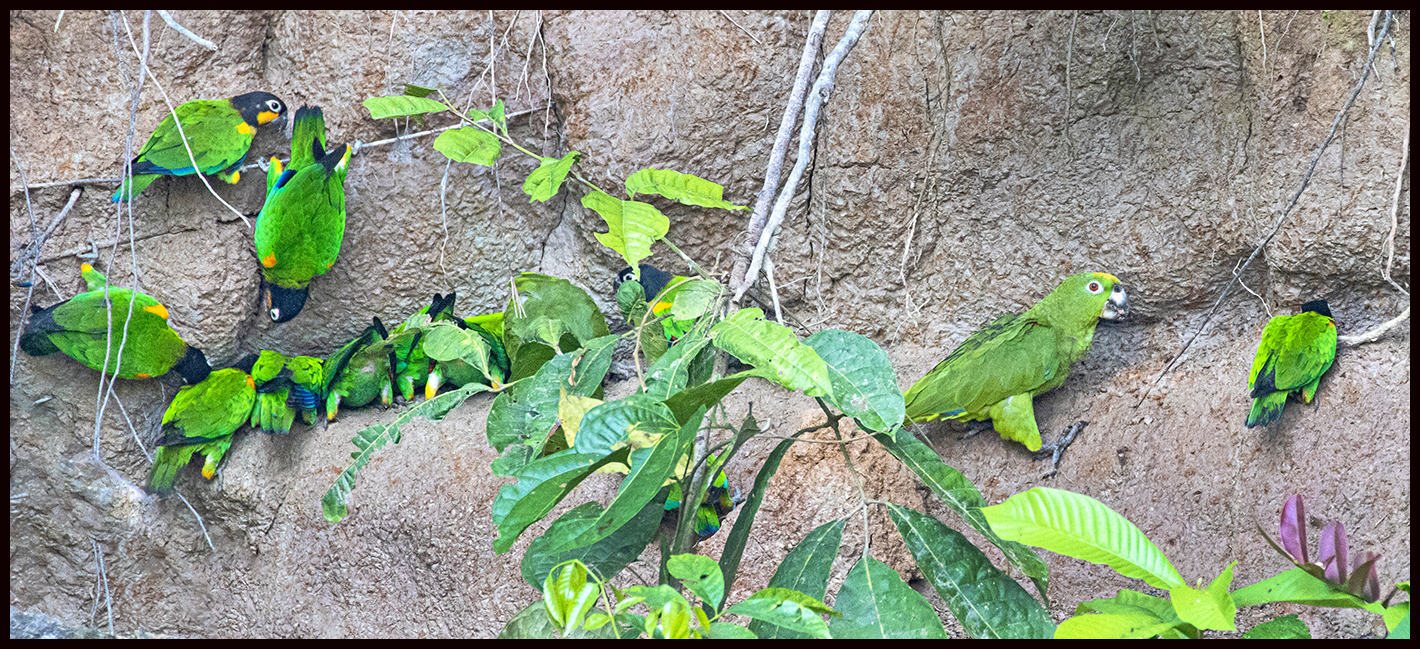
Clay lick in Ecuador’s Cuyabeno with Mealy parrot and many Orange-cheeked parrots.
The reason we returned to Ecuador was to see parrots on a clay lick. In 2016 when we were nearby, the tours we found were too expensive. When I discovered online the modestly priced Kichwa Lodge offered parrots on a clay lick, I booked the tour even though the Cuyabeno only has one small clay lick. There are two much larger ones in the Yasuni Nat. Park along the Napo River, which attract more species of parrots… but it’s far more expensive to see these bigger licks and tourists don’t get nearly as close. Tradeoffs.
Now I’ll backtrack to where the first chapter ended. Ah yes, we were at the second lodge with a couple more nights to go. The routine: Up at 6AM, off on wildlife spotting missions, back for breakfast. Some time to ourselves before going out in the boat again for more adventures. Lunch on a riverbank wherever we happened to be at noon and back for dinner.

Nunbird

Red howler monkey family
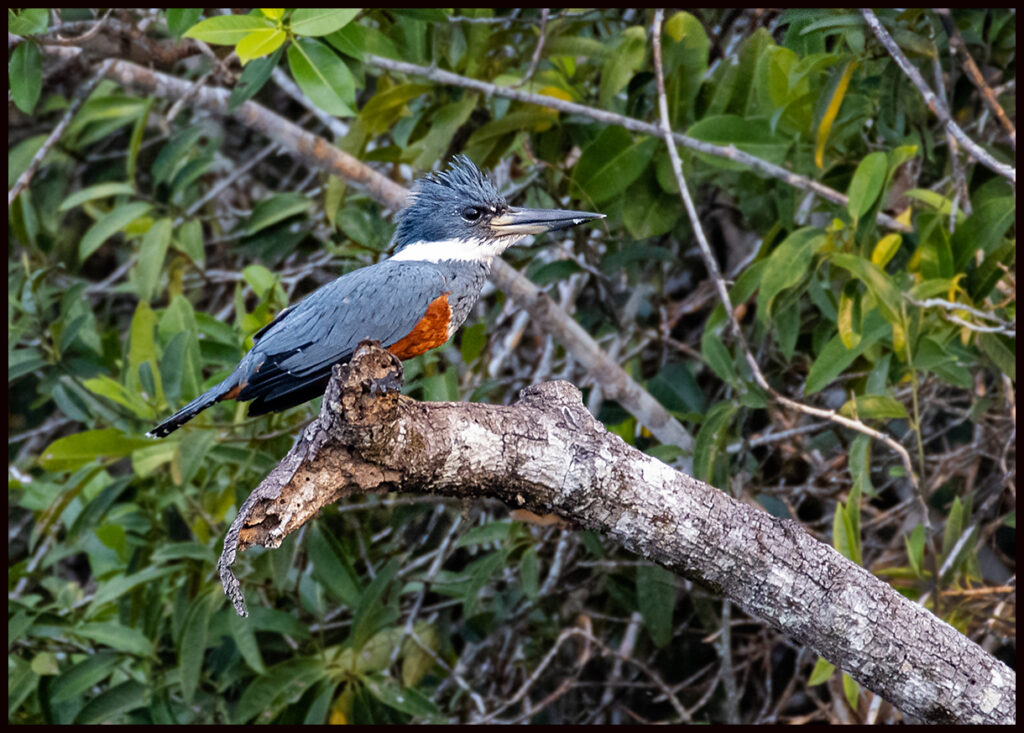
Kingfishers are common. This one, a Ringed Kingfisher
Heliconia variety
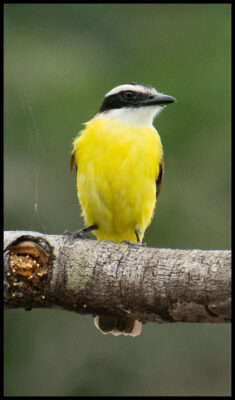
Lesser kiskadee. Many flycatcher species look very similar. They’re difficult to tell apart. George’s photo.
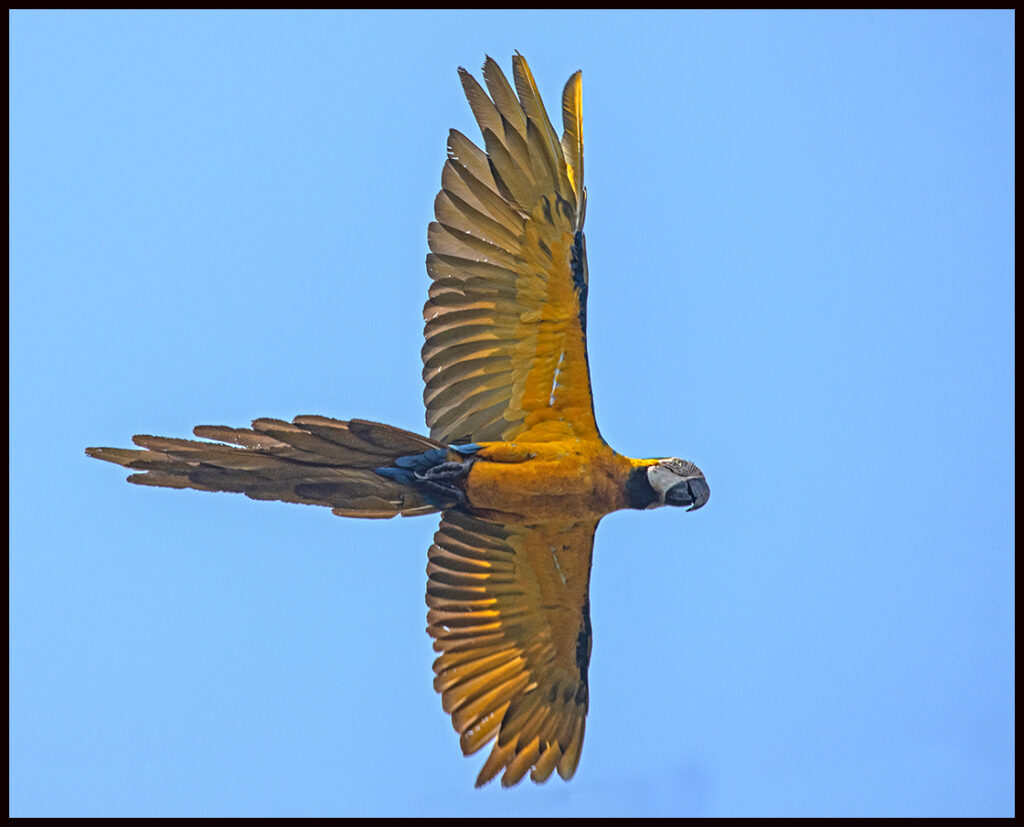
Blue-and-yellow macaws are seen frequently.
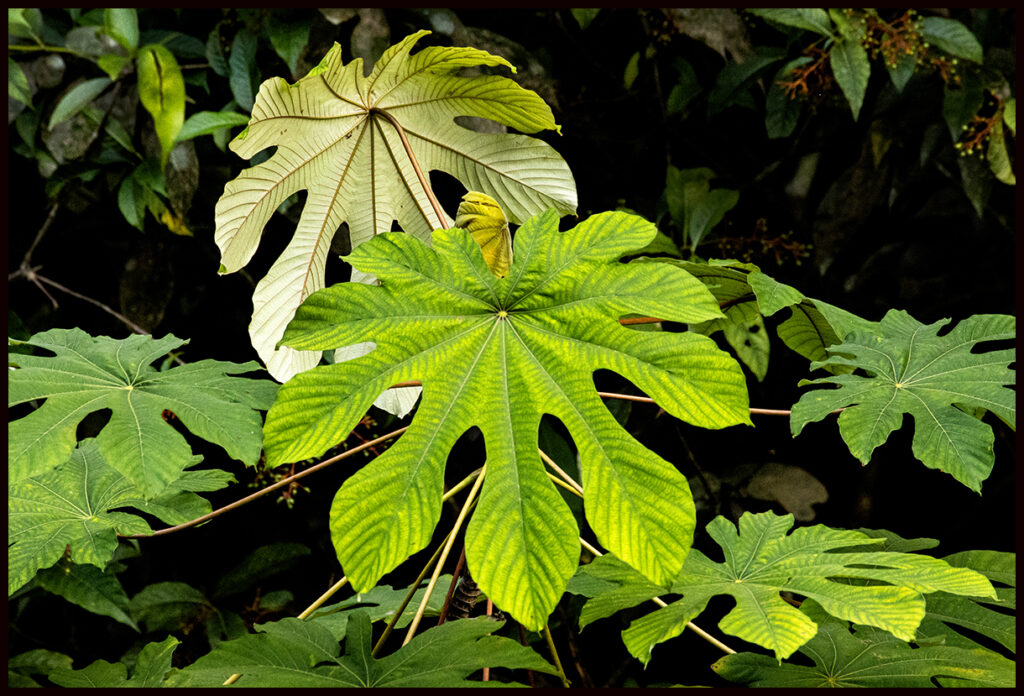
The leaf shapes, sizes and variety are amazing
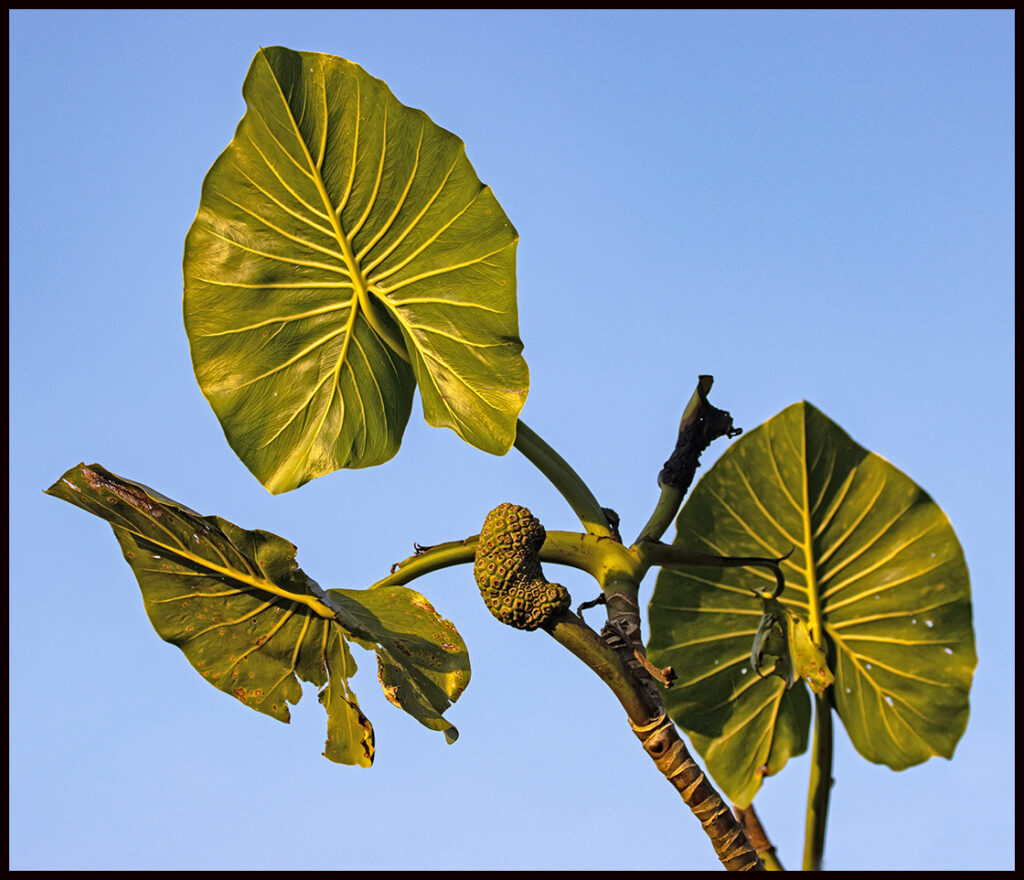
More huge leaves
We saw Napo-Saki monkeys, endemic to eastern Ecuador and northern Peru. These monkeys live high in the jungle canopy, rarely coming to the ground. We were lucky to see any as they are shy, solitary and quiet. Their hair stands up to make them appear larger than they are. They have big, furry tails.
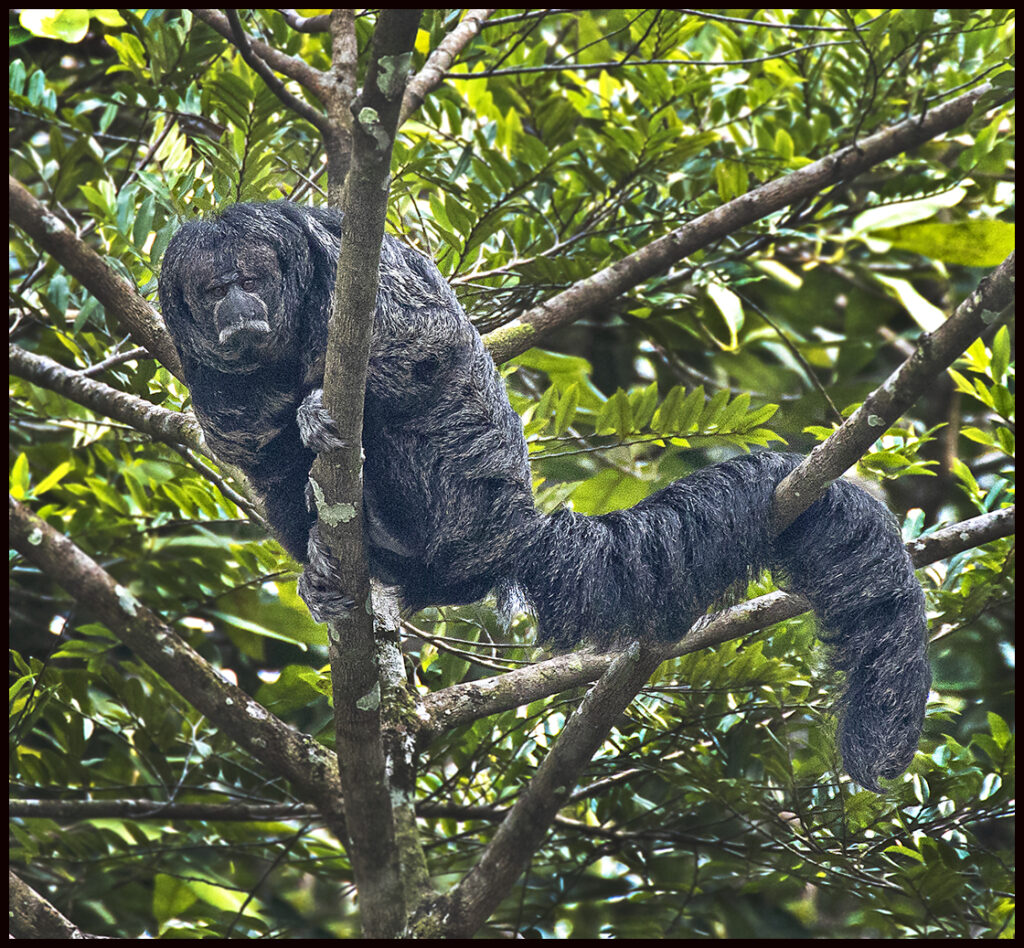
Napo-Saki monkey watching us.

We also saw some Wooly monkeys, but I didn’t get a photo. This is an internet pic.
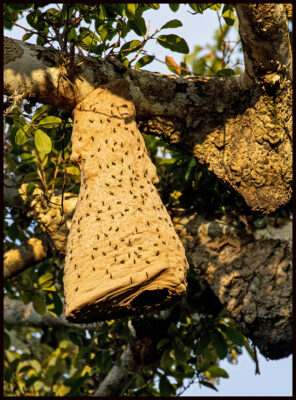
Another variety of wasp nest. Insect life abounds.
I’ll insert Craig’s version of what happened next.
“On our evening cruise, we began with a trip up a side river to a large lagoon. The trip was difficult because the river was narrow in spots, and the outboard motor apparently had water in the gas and only worked at full throttle. A guide in the bow tried to fend off trees, the banks, and other hazards with a pole while the pilot turned the motor on and off. Then we discovered the way was blocked by a floating island plugging the lagoon’s outlet.
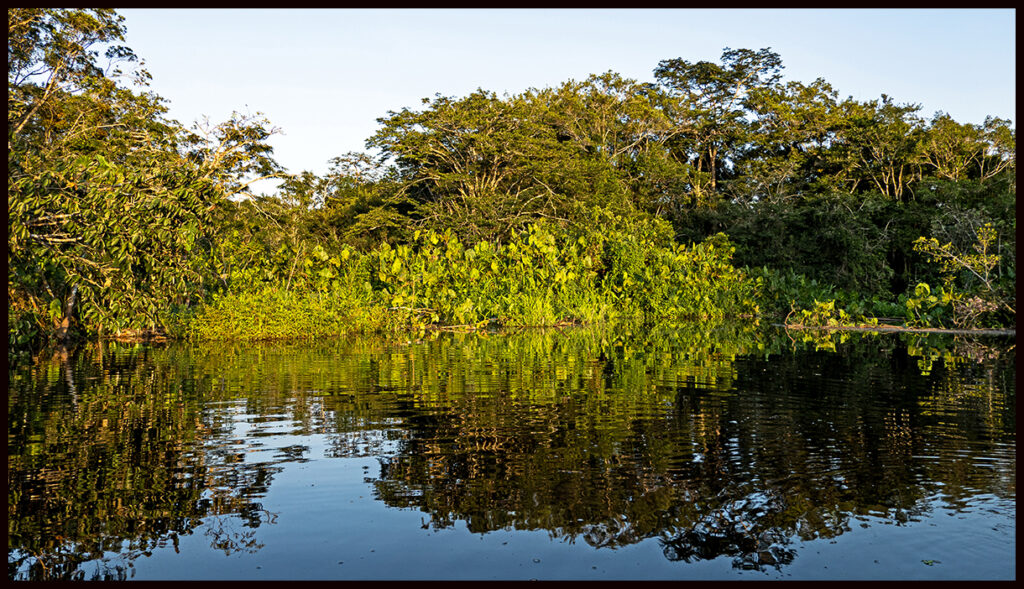
A large floating island blocked the entire river channel.
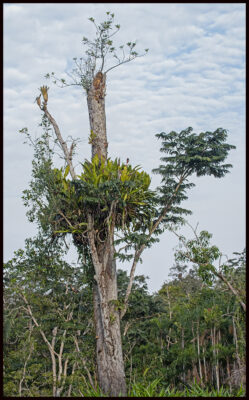
Nearly dead snag with large bromeliads.
These floating islands form when a tree falls into the water, and the tree with all its bromeliads and vines continues growing. Water plants get tangled in the mass, and seeds blow or wash in, and sprout. Eventually you have a large, unstable floating mass. These islands are common in these parts.
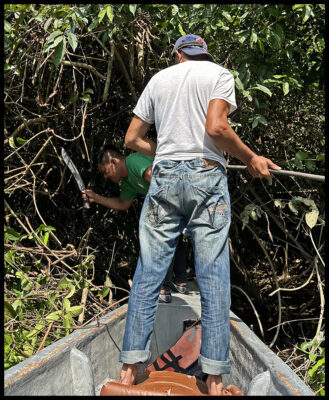
Hacking through the floating island. Photo by George Cribb
Rather than alter the plan, our guides decided to hack through the island at the edge where it joined the riverbank. After an hour of hacking with machetes, rocking the boat, and gunning the engine, we popped out into the lagoon. We continued our tour around the lake as if nothing had happened. At sunset we paused to watch egrets and cormorants return to their roost trees. In the semi-darkness, the channel that the guides had hacked through earlier was invisible and had closed. Aiming at the general location and gunning the motor, they hoped to break through. Instead we got horribly stuck on top of the island. It was getting dark, really dark, and swarms of mosquitos emerged. The guides hacked at the vines by the light of their cellphones. Even if the people at camp knew where we were, they didn’t have a boat to rescue us. We imagined eventual rescuers finding our shriveled bodies, drained by mosquitos, lying lifeless in the bottom of the dugout. Then the guides had an idea. If we all got out of the boat, maybe we could drag it across. Standing on the unstable island (with caiman below?), in a swarm of mosquitos, we all tugged at the dugout. We’re here to tell the tale, so obviously we got back; the mosquito bites now only a bad memory.”
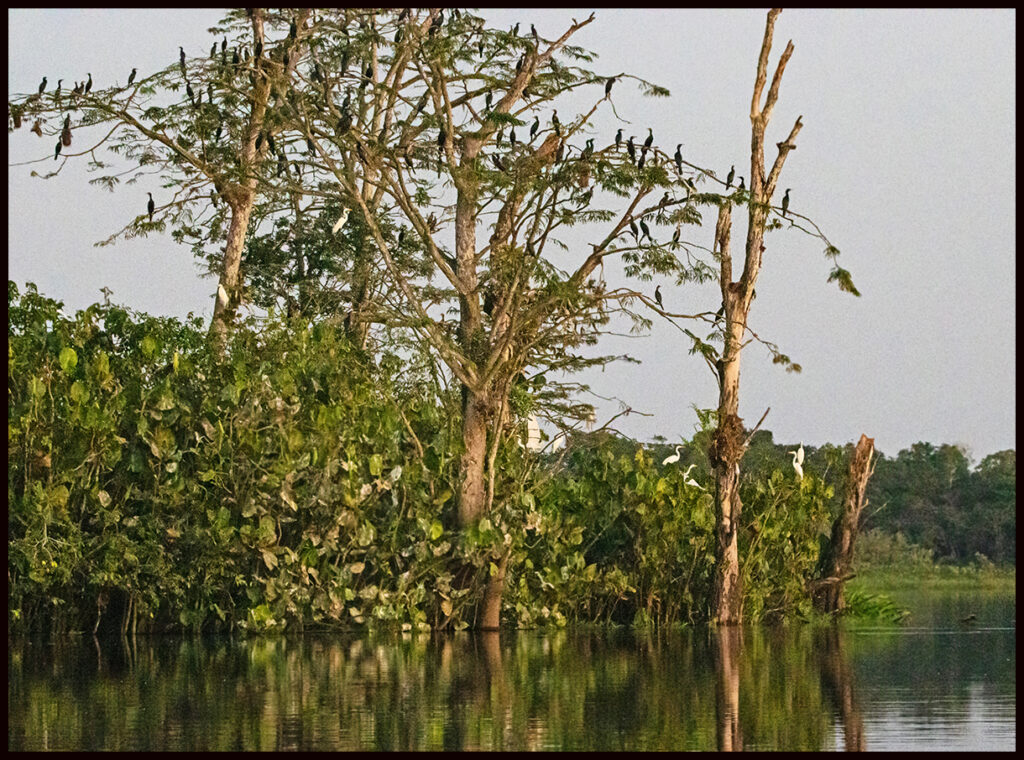
Roosting tree
The next morning we said good-bye to our riverside home, loaded up and set out for a new adventure.
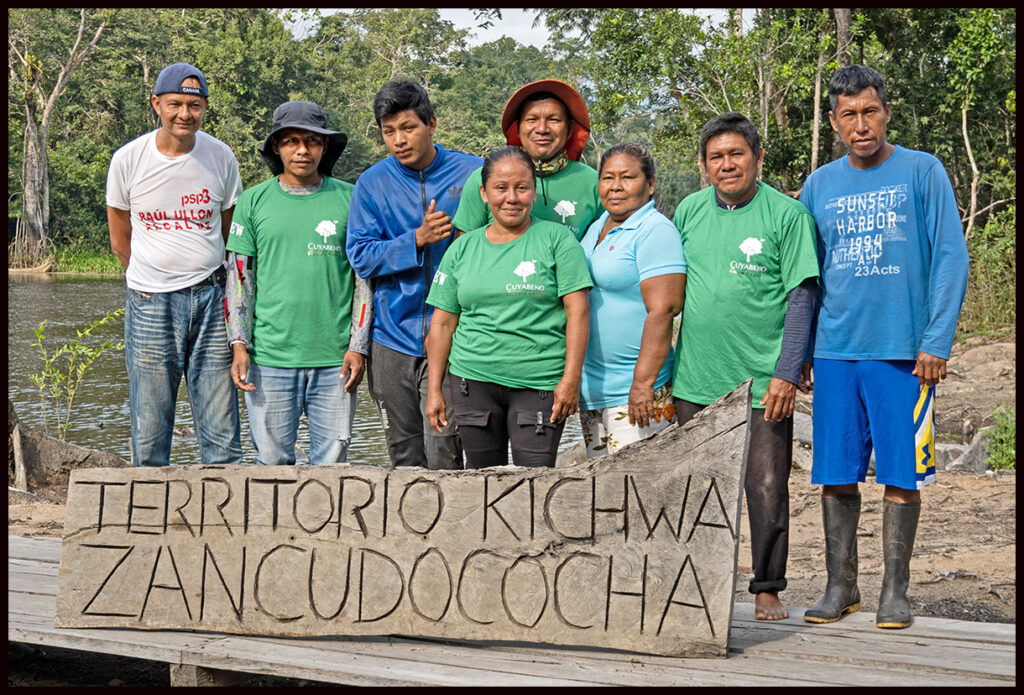
The wonderful staff at the second jungle lodge. Edgar has the red hat.
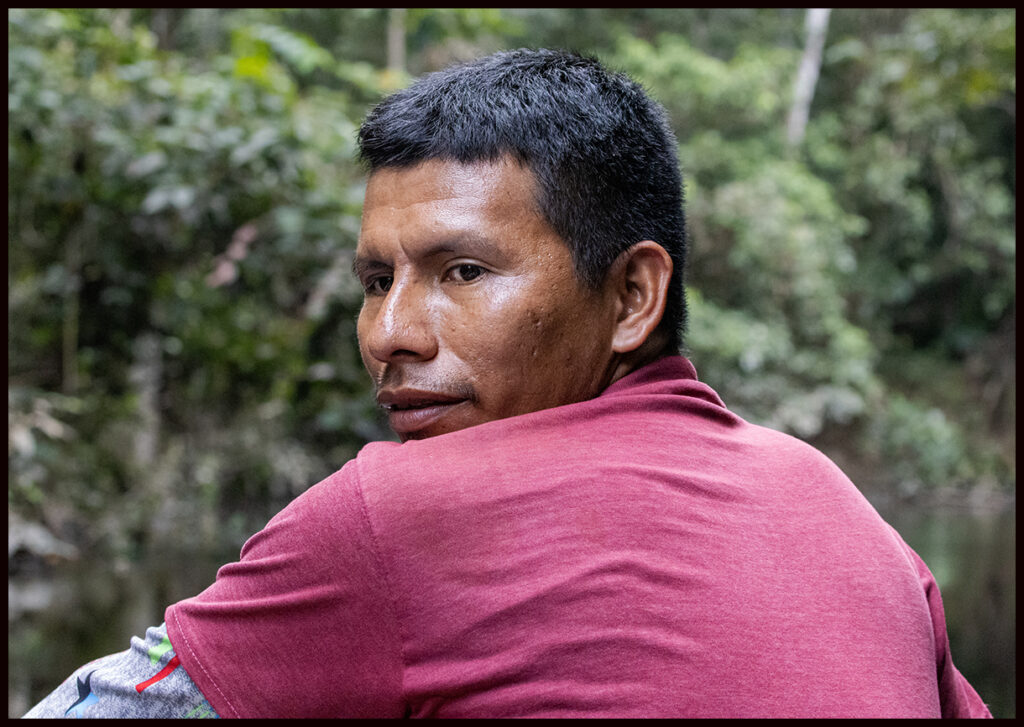
Ramon
On the way to our next glamping opportunity we stopped in at a village that had internet so Edgar could take care of his business. Ramon took the rest of us across the strangely empty town and up a hill to a large building that turned out to be the local bar. We gringos had for days been fantasizing about how nice it would be to drink a cold beer…
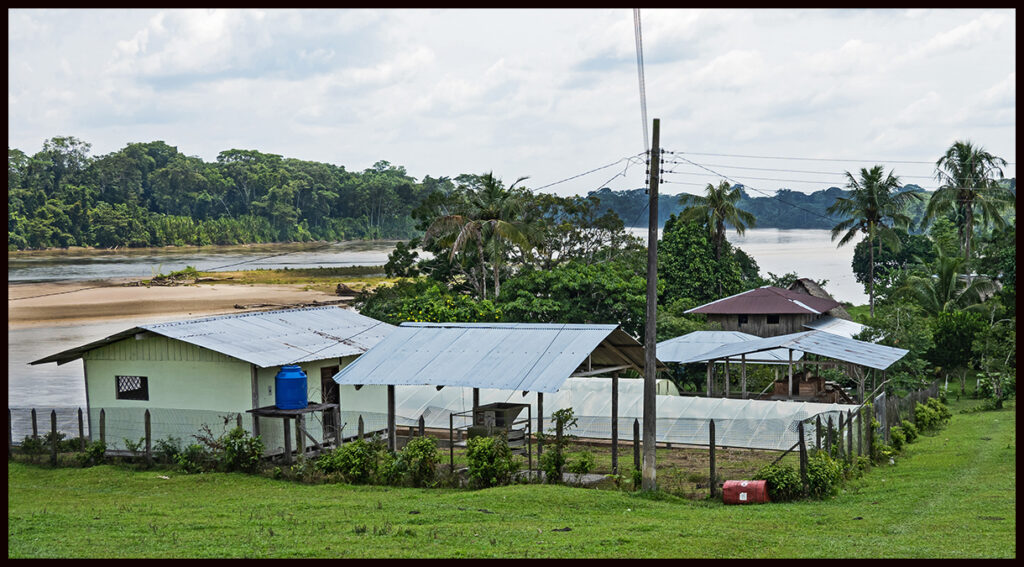
Strangely quiet village.
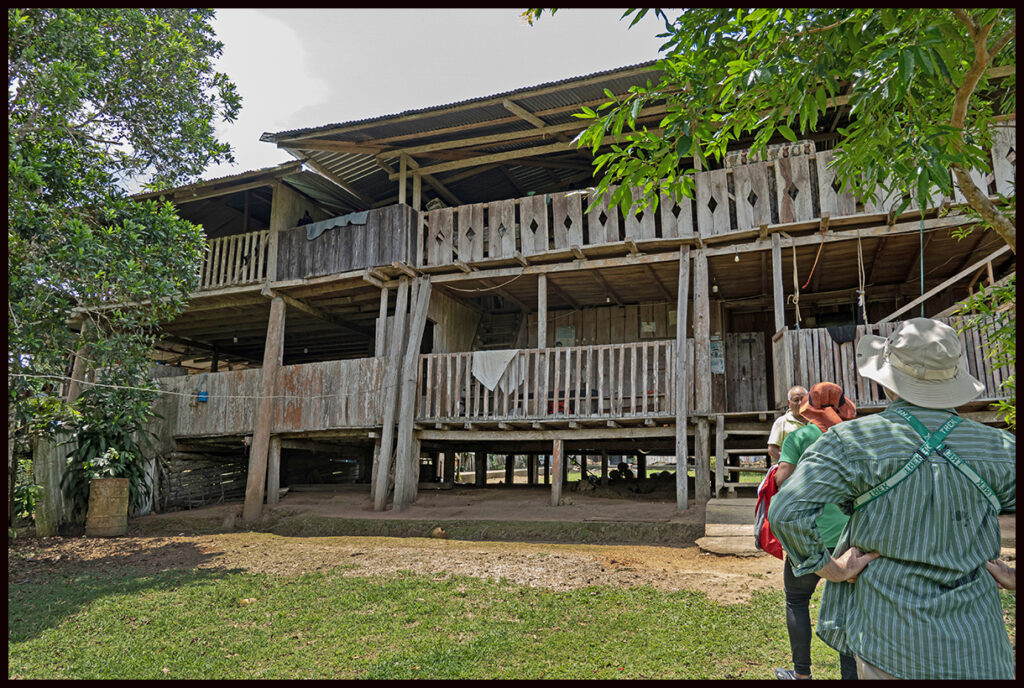
The bar.
Craig’s description follows. “The room had a couple of open windows overlooking the town, a few benches, and a pool table. No one was there, but after we filed in, miraculously a small half-door in the wall opened and we were sold liter bottles of Pilsener beer. It was tepid, but the flavor improved the more we drank. Ramon found balls and cues, and the great playoff began between guides and gringos. The guides were hustlers. We beat them in the first game on a technicality when they sank the eight ball. (They claimed they’d never heard of that rule.) The second game was a raucous affair as the beer was having its effect. They won that one by a couple of balls, then we staggered down the hill to lunch.” After lunch we continued on to one of the largest lagoons in the entire Ecuadorian Amazonia, Zancudo Cocha.
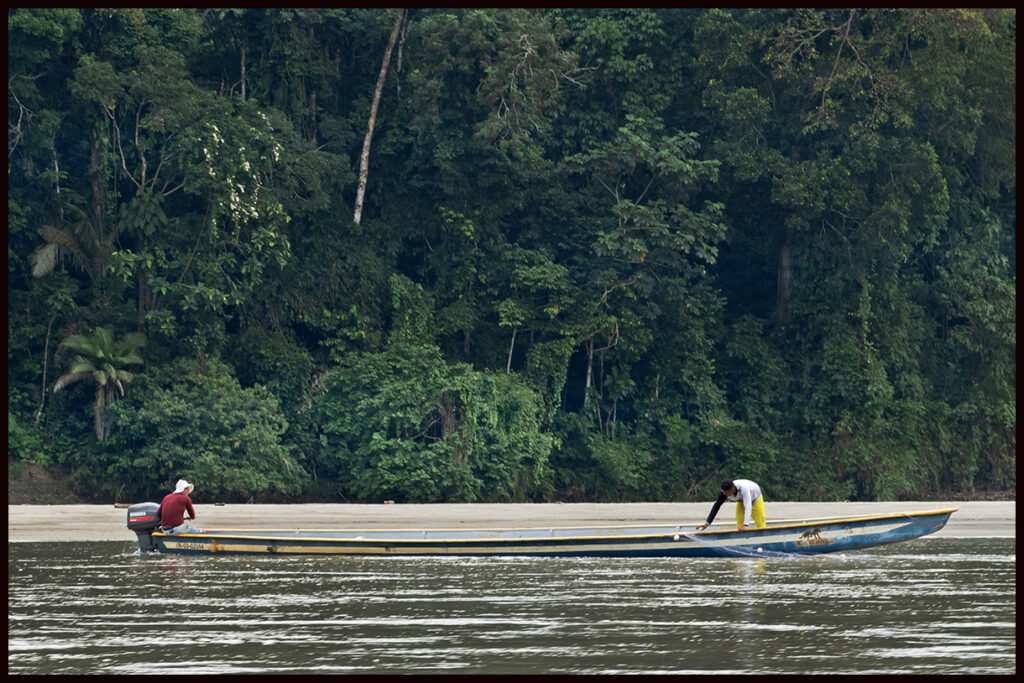
Long boat on the main river.
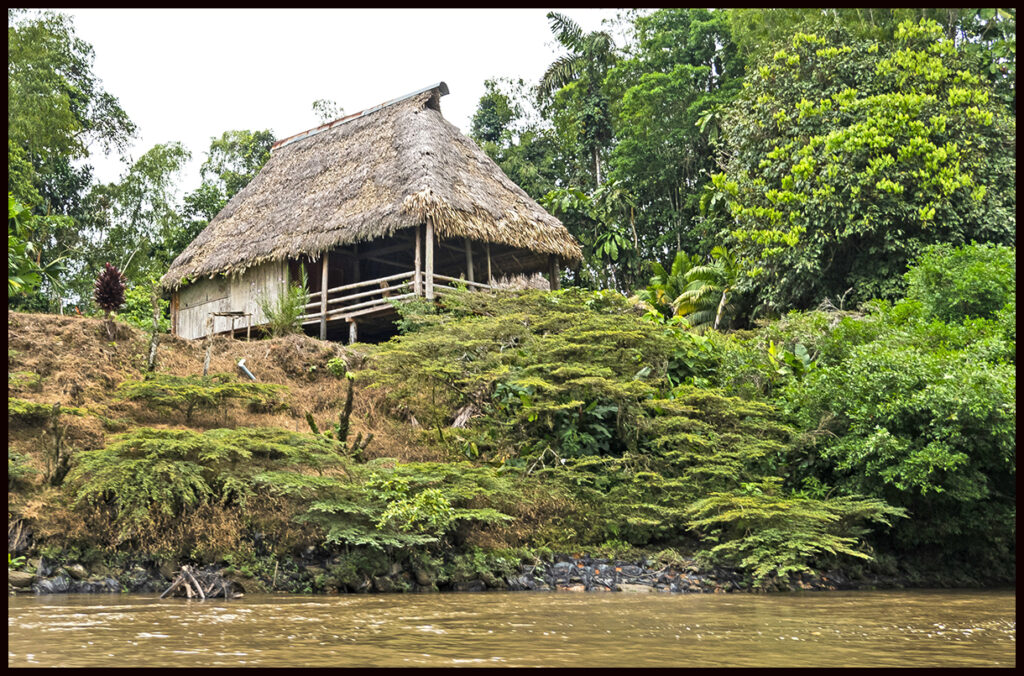
Native guardhouse at a confluence point. They try to ensure everyone behaves in the reserve with perhaps mixed results. It’s a huge area to patrol.

Black-water river bank.
I should mention that black-water rivers are called that because the water flows so slowly the mud on the bottom doesn’t get stirred up and tannins stain the water.
Up and down, in and out of numerous big and small rivers, we eventually arrived at an enormous lagoon. It was so big we could barely see the opposite shore.

Riverside trees at sundown
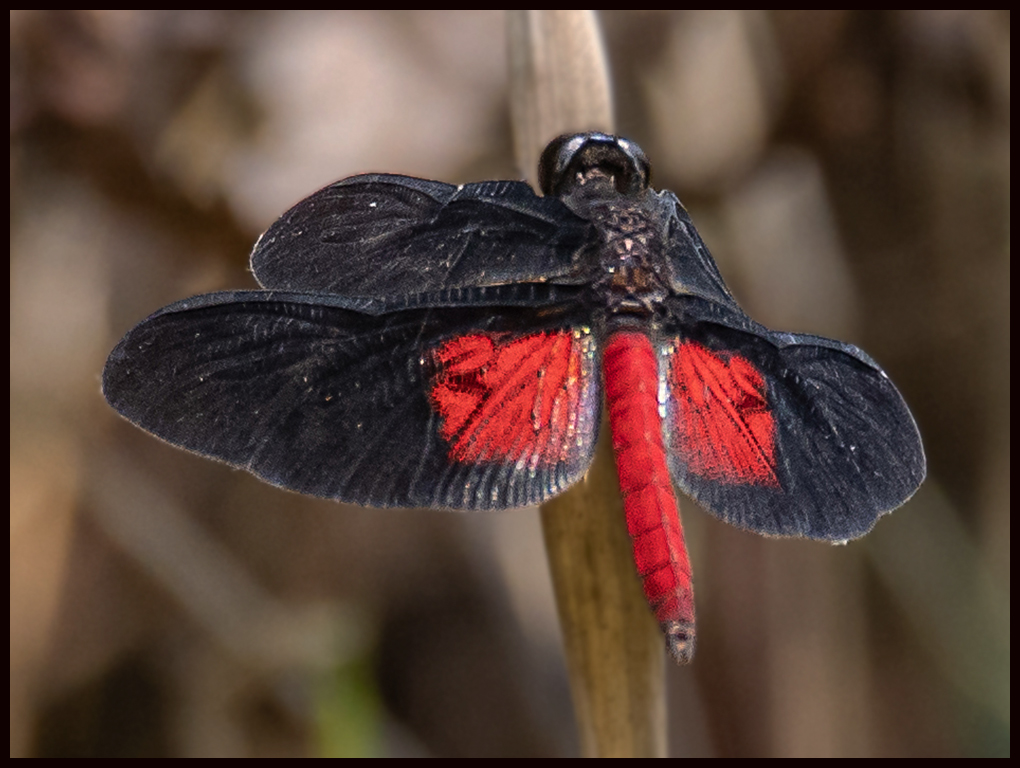
Many of these dragonflies lined the narrower passages.
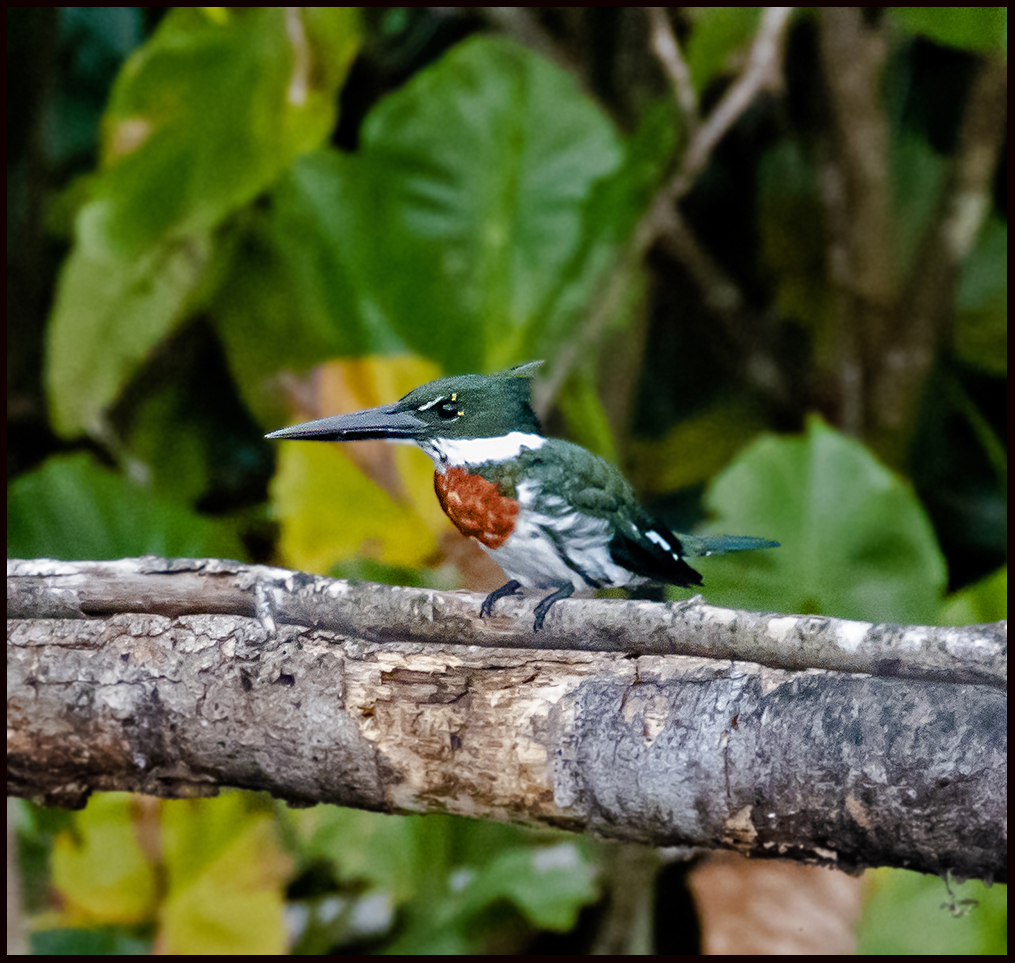
Green kingfishers dove for fish.
Craig again. “We tied-up to a fallen tree and climbed out onto the mud and up small steps hacked into the steep clay bank. Atop was a rudimentary building which appeared to be abandoned. A large clearing had been burned leaving ash, tile, and cinderblock remains of what must have been a grand resort. One of the guides explained that local natives, unhappy with the resort built by outsiders, had burned it down and built their own building on the site. They planned to upgrade soon (eventually).
The guides hauled our tents and cooking gear up the bluff so we realized this was our campsite for the night. No water, no electricity. Leslie asked about a toilet? Dig a hole in the jungle. Shovel? No shovel; use a stick. There was a porch just big enough for our three tents, and we built steps up to the raised floor from old storage batteries found in the rubble. The crew had an even smaller platform for their tents.”
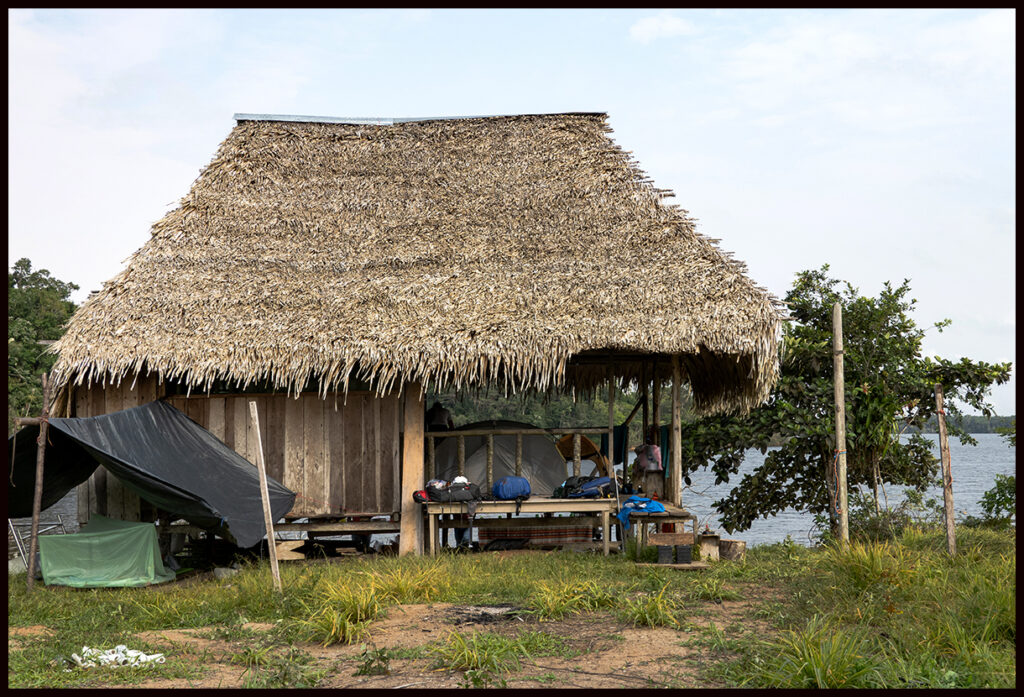
Our building with small tarp covered sleep area for one crew member on the side.
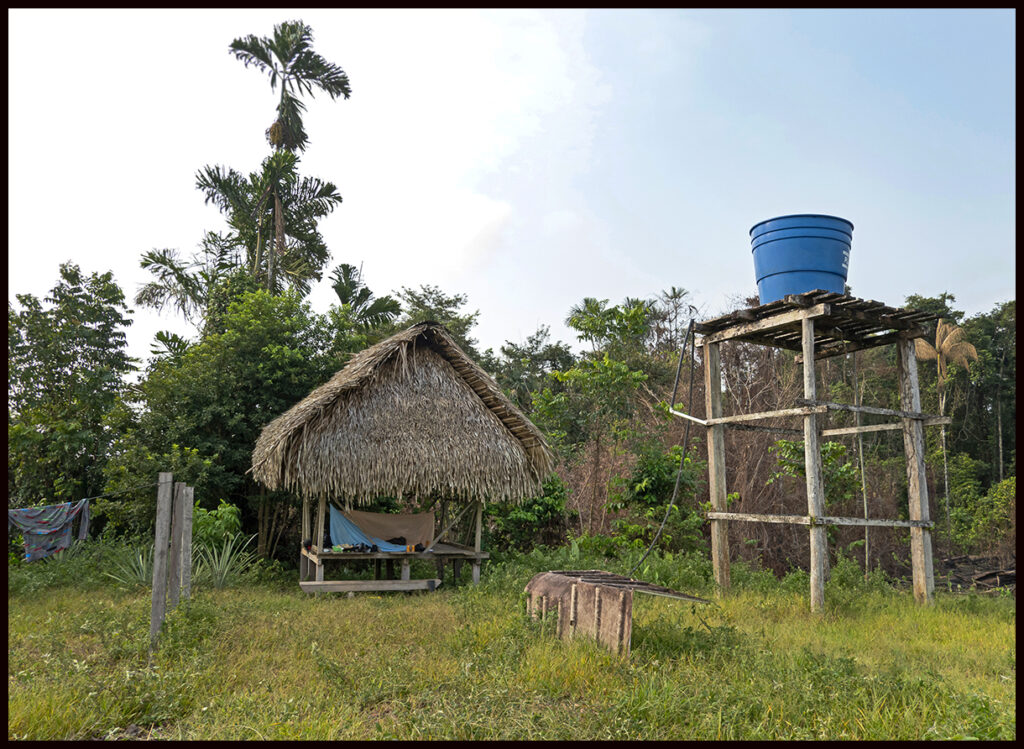
The rest of the crew slept on this platform.
“With such a lovely lagoon at our doorstep, and after a sweaty day, we looked forward to a swim in the clear water. Alas, Edgar discouraged us. Why? Piranas? Caiman? No. Electric eels! Oh bother!” Craig and George managed a sponge bath in the shallows, I just marinated in body oils.
Again, Craig. (I warn you, Craig hates spiders.) “During our candlelight dinner at a picnic table in the burned clearing, we decided we would take a nighttime jungle stroll to see what was out there. After a liberal dousing with DEET, we got our headlamps and followed our guide, Ramon. Spiders the size of my fist hung in webs at face level, while others scurried across the ground, looking for an opportunity to run up my pant leg. Walking sticks, moths, and cryptic katydids were invisible until the guide pointed them out. Millipedes and giant ants with terrible stings patrolled the ground. Leslie was of course in heaven.”
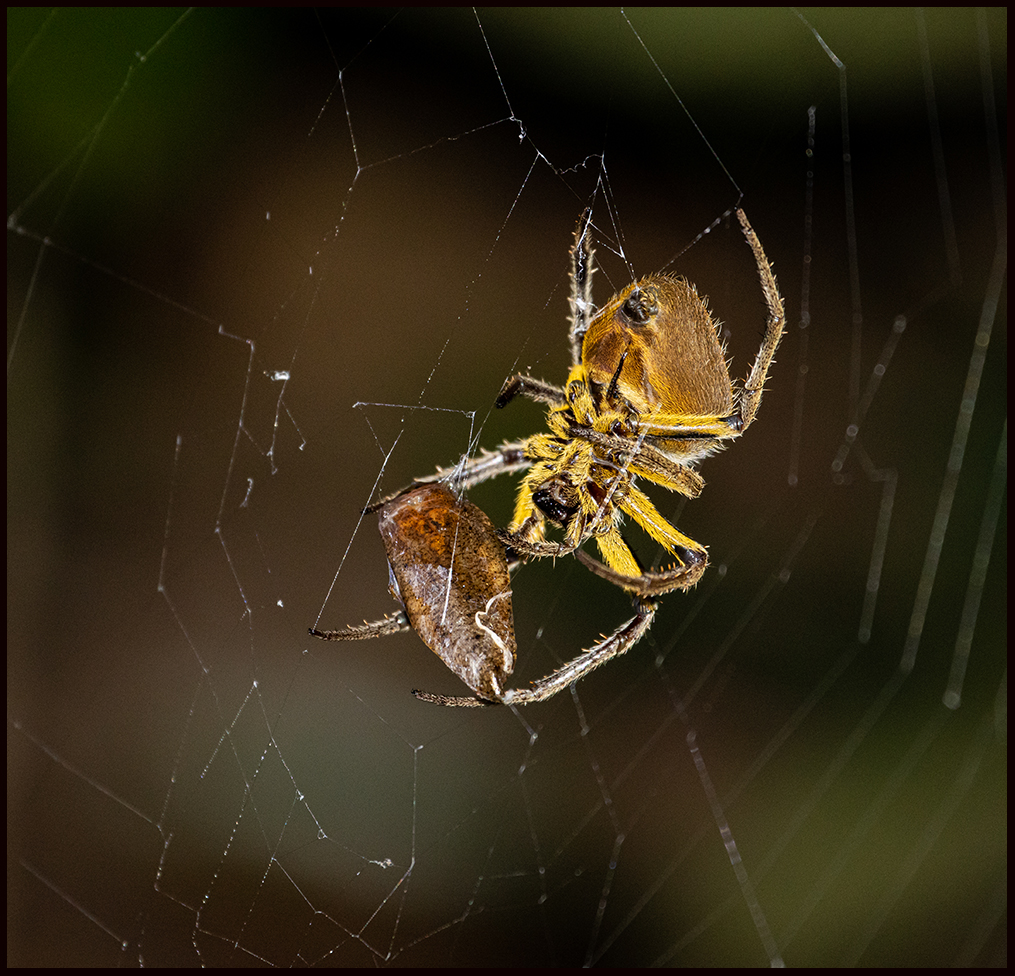
Large spider with dinner
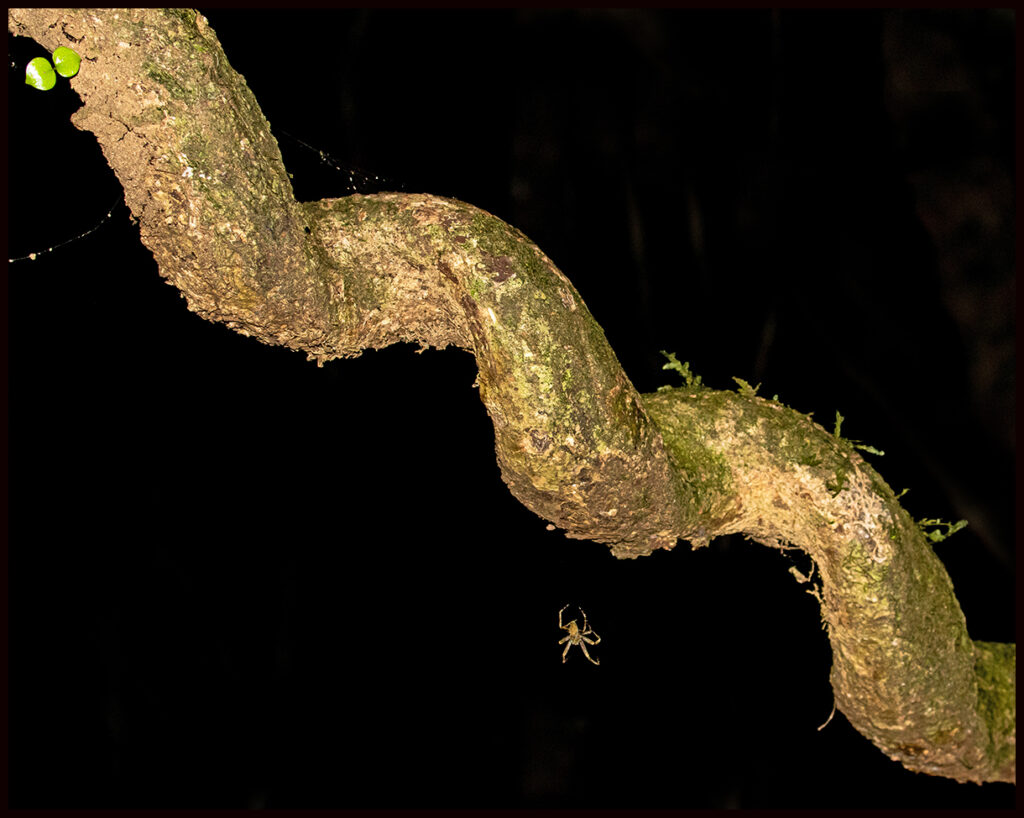
Vines are everywhere in the jungle.
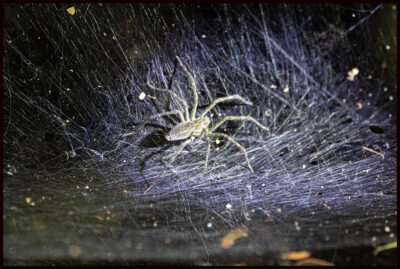
Another spider
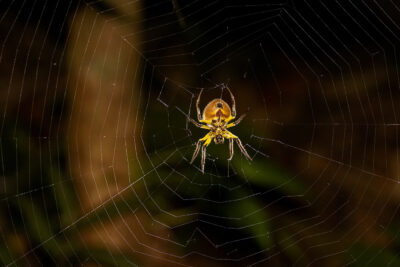
…and another
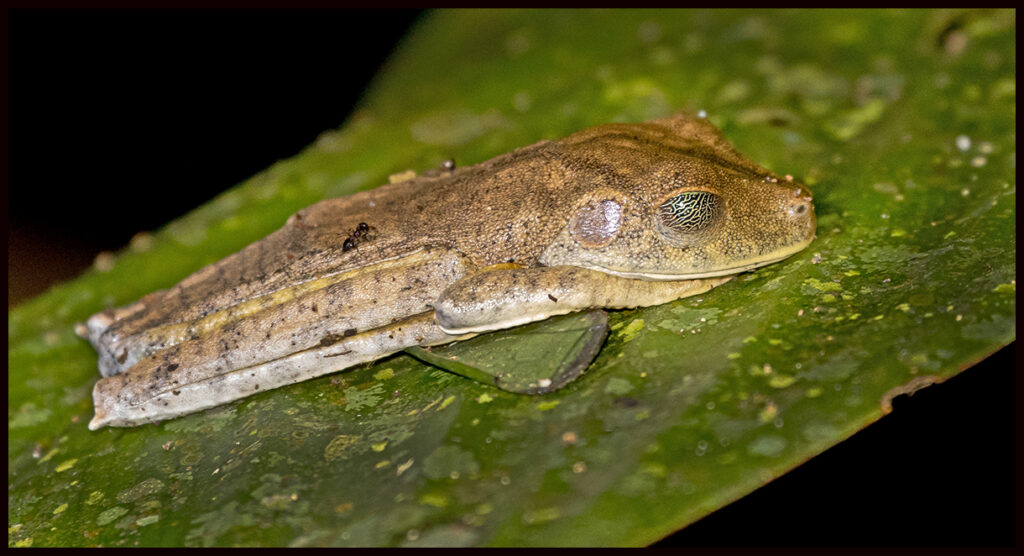
Some sort of strange frog.
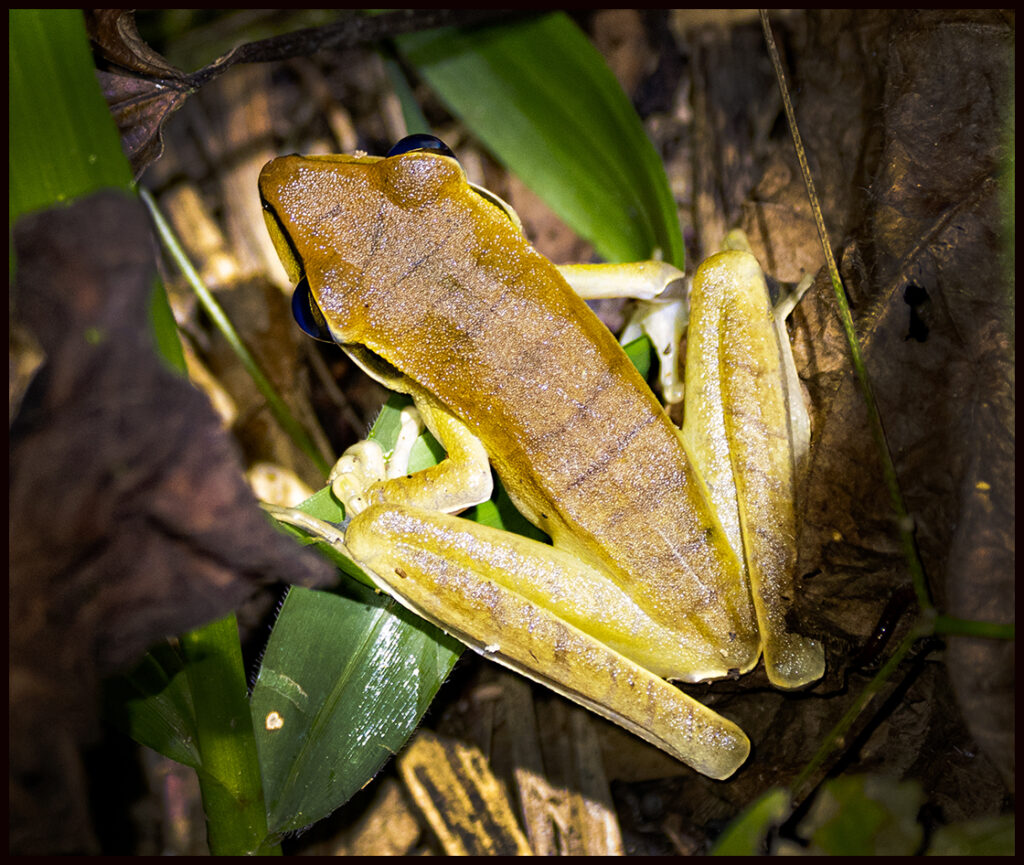
A more normal looking frog.
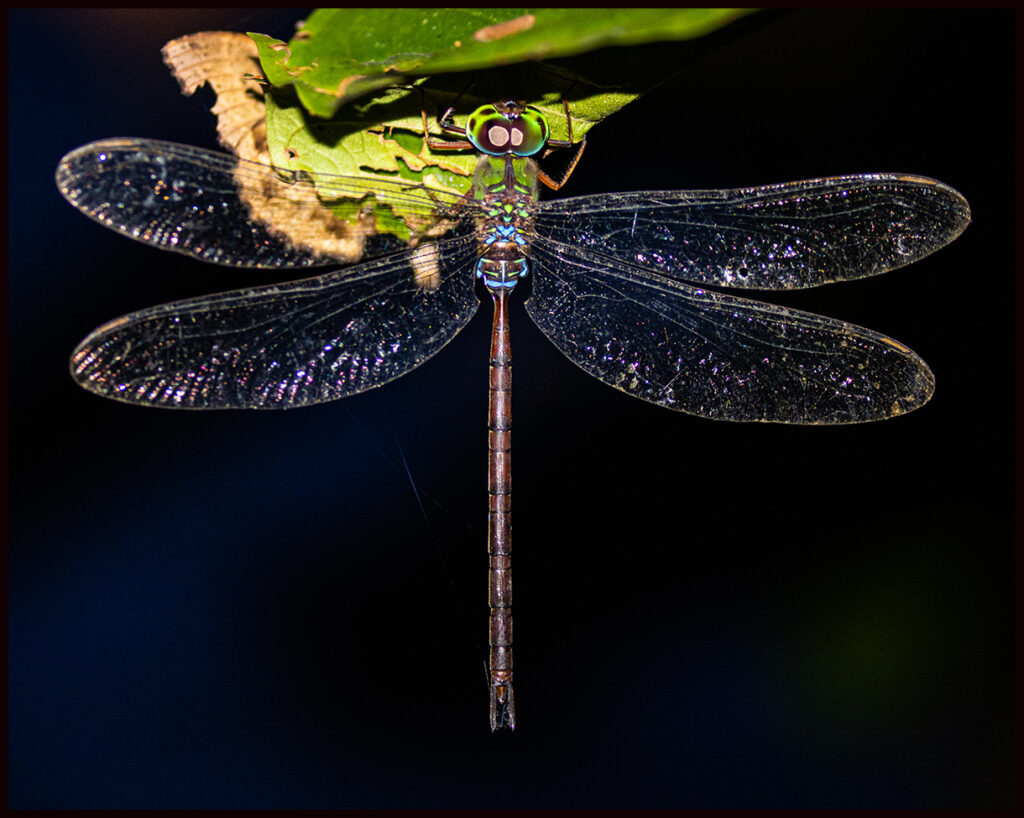
Sleeping dragonfly.

Katydid. photo by George Cribb
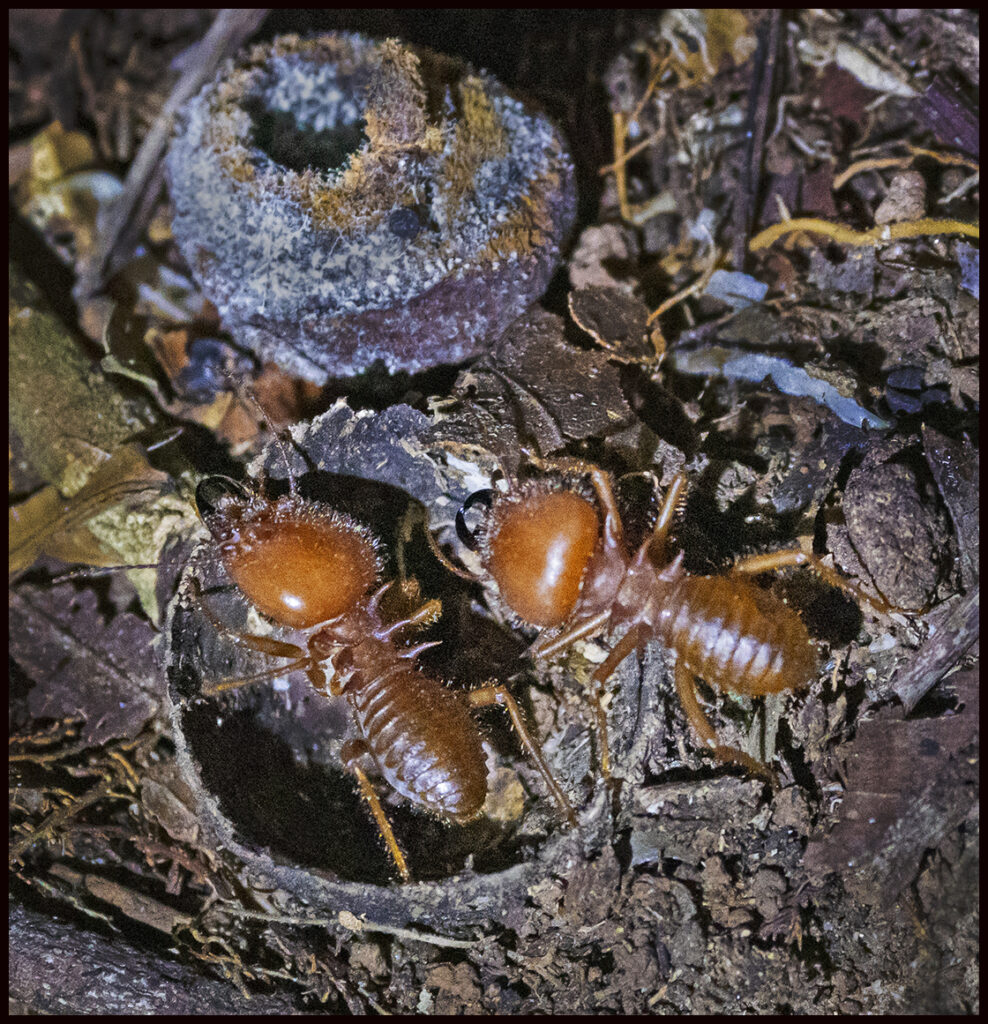
Bullet ants. These you do not want to cross. Their sting of neurotoxic venom is the highest on the Schmidt’s pain level index of any insect in the world.
There were many more insects of interest, but it was getting late so we headed to our tents. The sketchy accommodations were forgiven the next morning as we circumnavigated the isolated lagoon. The blue skies held and the wildlife viewing was spectacular. Many of the more exotic birds escaped my camera.
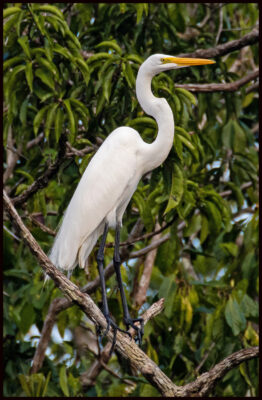
Great egret

Little blue heron
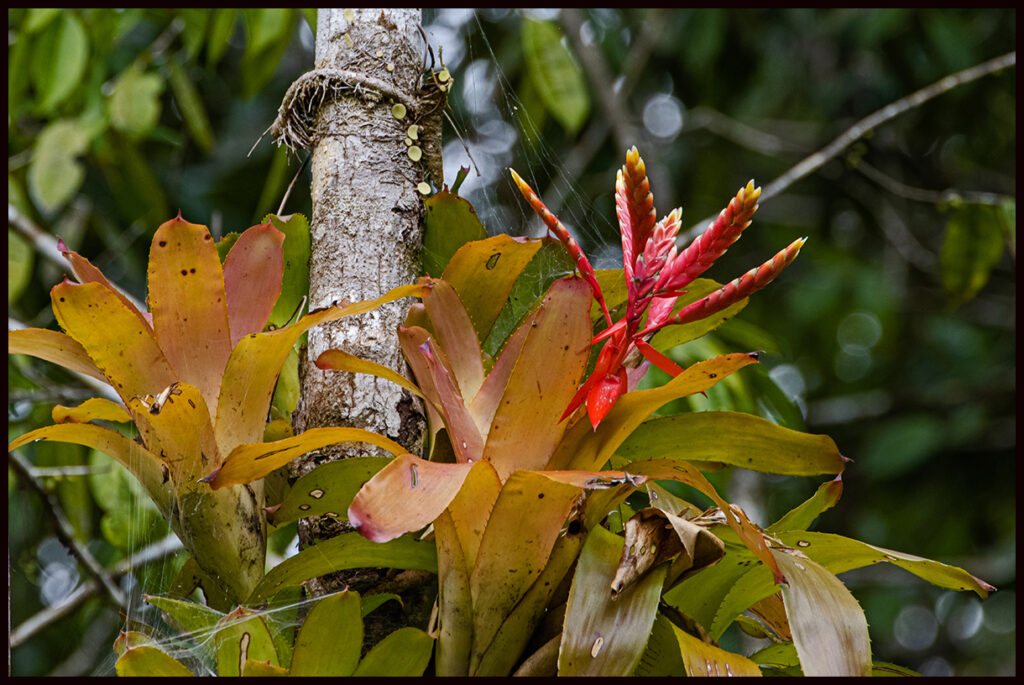
Colorful bromeliads cling to every tree.
Proboscis bats (Rhynchonycteris naso) are the only species in their genus. They hang on branches near water during the day, but when a boat approaches, they all scatter. There were hundreds of them.

Proboscis bats hang during the day on lagoon-edge branches.
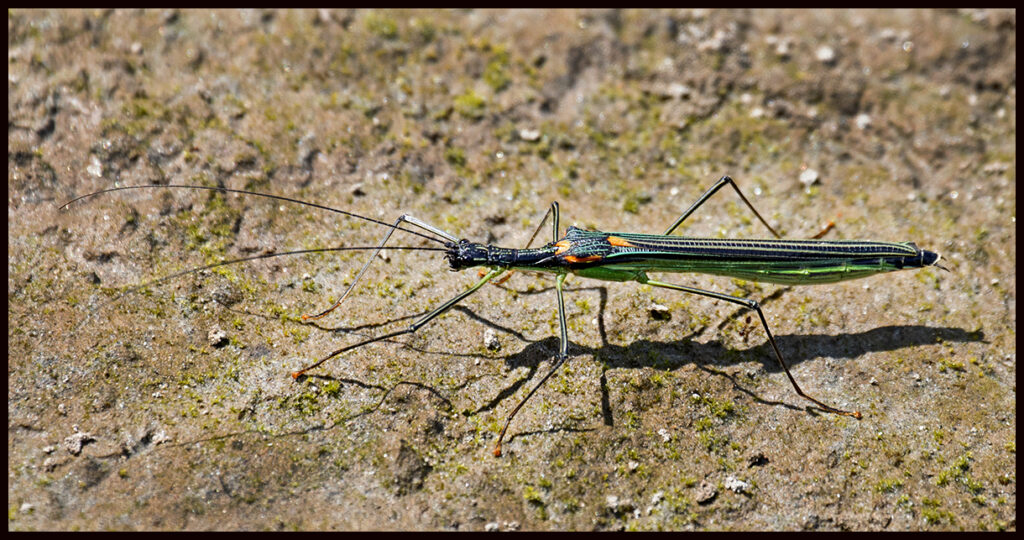
Unusual mantis type insect.

Flower I liked.
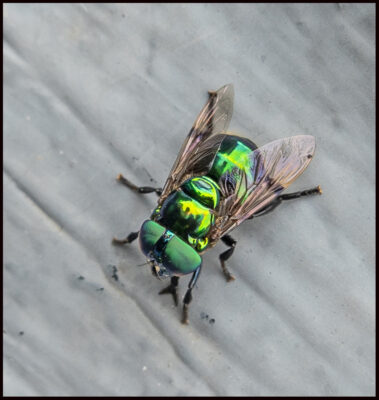
Hitchhiker in the boat.
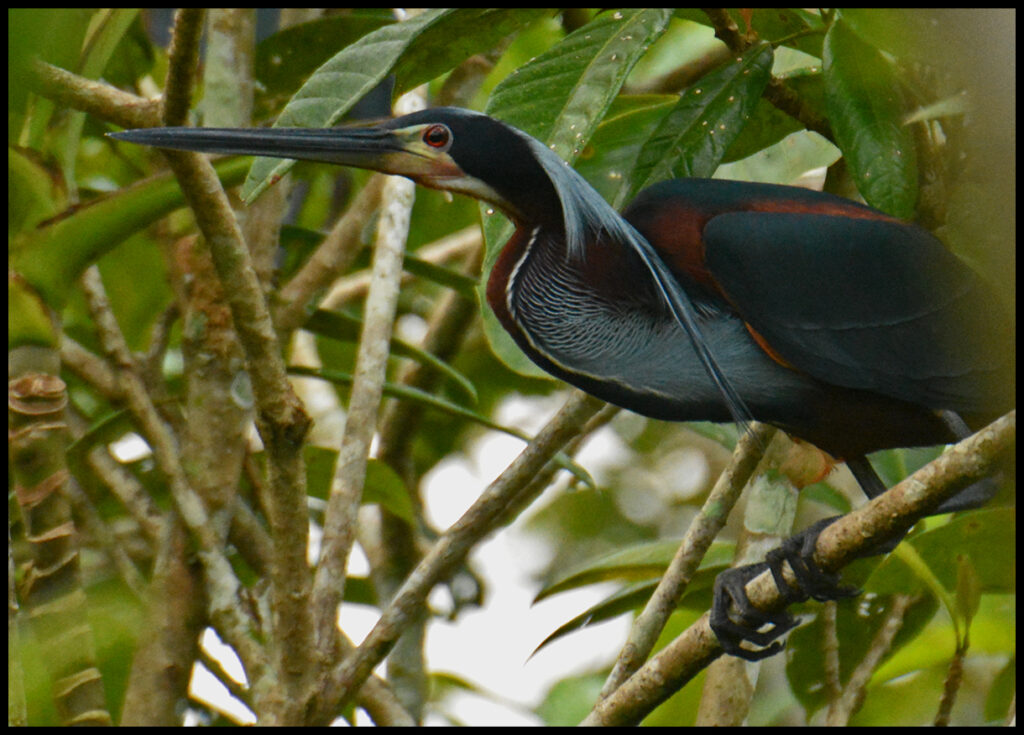
Agami heron. A quick view, and gone. photo by George Cribb
But now it’s almost time to say good-bye to our new friends. We get to spend our last night in the original lodge with all the amenities before leaving very early in the morning for an observation tower and then the final event…the CLAY LICK!
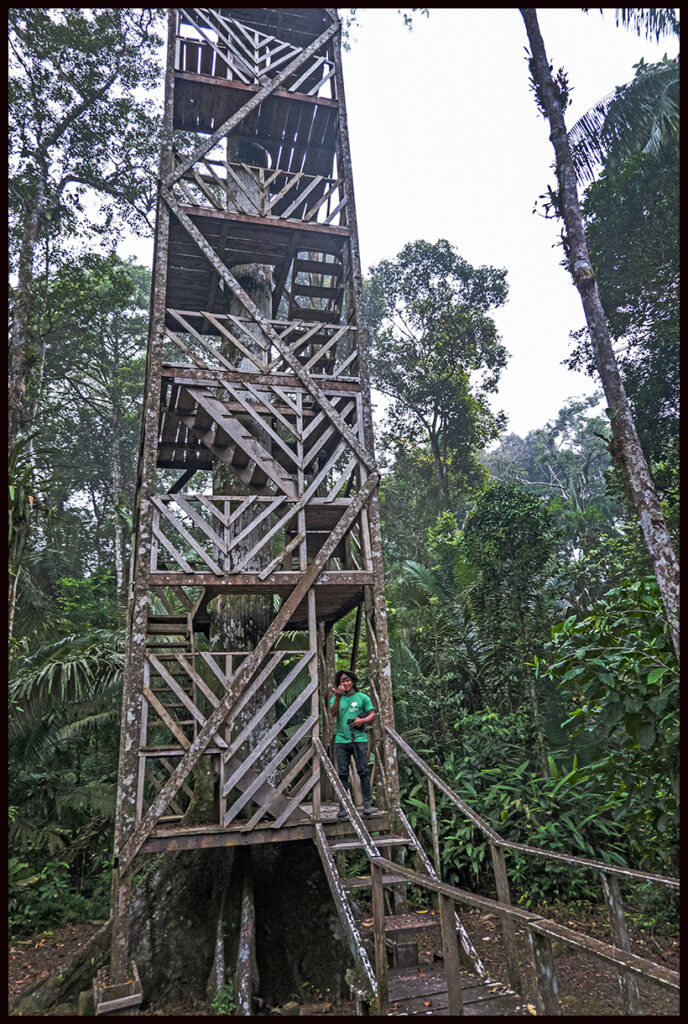
The tower with Edgar beckoning.
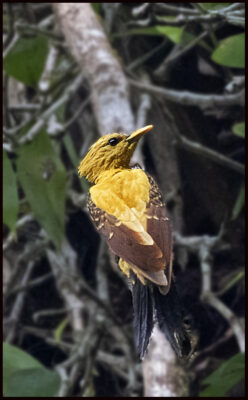
Cream-colored Woodpecker, female

Squirrel monkey
Two of the critters seen from the tower, and then, FINALLY, the clay lick.
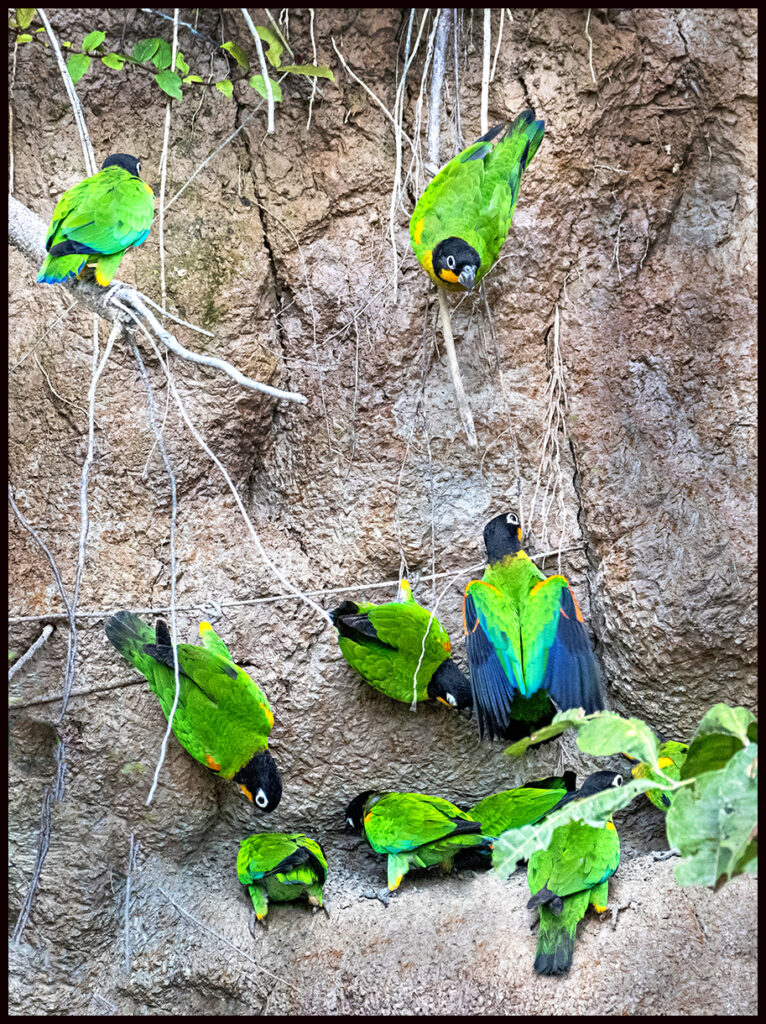
Parrots on the lick

This orange-cheeked parrot wishes you well until the next chapter.
If you are interested in seeing the parrots in action, click the link for a very short video shot by George with his cell phone.

